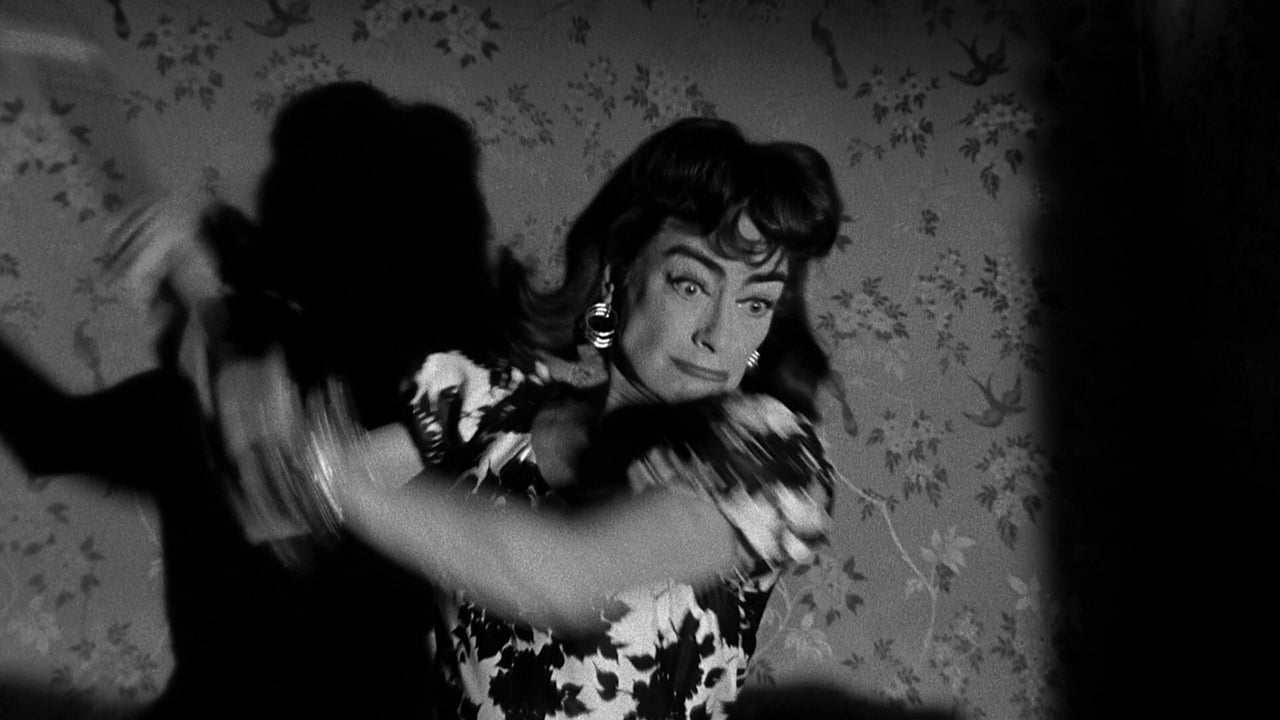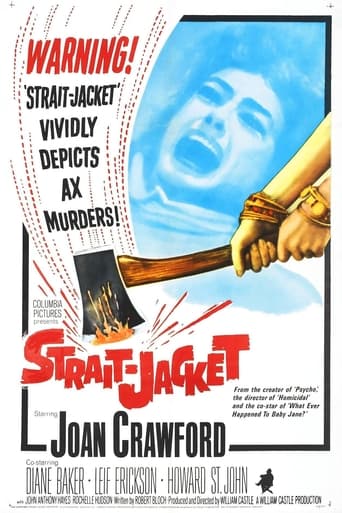

Very Cool!!!
... View MoreAn action-packed slog
... View MoreA clunky actioner with a handful of cool moments.
... View MoreThere's a more than satisfactory amount of boom-boom in the movie's trim running time.
... View More"Lucy Harbin took an axe, gave her husband forty whacks, when she saw what she had done, she gave his girlfriend forty one." So is the life of Lucy Harbin, played by dynamite Joan Crawford. After spending twenty years in an insane asylum for her crime, she is released and goes to live with her daughter on their farm property, but it is not long before goings on around the farm seem to point to Lucy's questionable sanity (and innocence).While William Castle earned his reputation for schlock-ridden gimmicky horror films, his pictures with Crawford are true gems; this film and "I Saw What You Did," to be specific. While Crawford's meditated approaches to performance are part of what made these films so effective, it is inarguable that these films were well written and well directed. Penned by Robert Bloch, the author of "Psycho," "Strait-Jacket" plays on Harbin's potential madness like piano keys— it's routine, sure, but for 1964, it's still a fresh approach to insanity on film. What's most surprising though is, as in "Psycho," the way in which the film's conclusion turns on its audience, and the plot twist is just as unexpected to a 21st century audience as it was in 1964.Crawford's dedication to her role in the film is astounding, and in "Strait-Jacket" she is able to take a stab at the madwoman villainess whom she played opposite to in "Whatever Happened to Baby Jane?" two years earlier. Crawford's determination and gall really pay off for her, because the role, no matter how dramatic or emotive it is, is convincing. Diane Baker plays opposite as Crawford's tormented daughter and is able to hold her ground against the grand dame of madness. Overall, "Strait-Jacket" is a solid thriller with Castle's schlocky touch, but its writing is sophisticated and its performances impressive enough to elevate it far beyond any sort of gimmick. The plot twists and Crawford's anti-demure playing of her character make this worth a watch. Along with "I Saw What You Did," "Strait-Jacket" is among Castle's classiest and most calculated thrillers. 7/10.
... View MoreWilliam Castle directed this (for its time) gory thriller that stars Joan Crawford as Lucy Harbin, recently released from a mental asylum after 20 years for murdering her husband and his girlfriend with an ax. Lucy comes home to stay with her now grown daughter Carol(played by Diane Baker) who had witnessed the crime, but seems to have adjusted well, and is planning on getting married when a new series of ax murders occur. Is Lucy reverting back to her old ways, or is someone trying to frame her? Unappealing and ridiculous film is solely for die-hard fans of Joan Crawford, the unmistakable star of this film, though Diane Baker is quite good in her role...pity about the twist ending!
... View MoreYou've got to give Joan Crawford credit. Like any good ball player, she remained on the team, pitching, catching and batting, sometimes in the minor leagues, but always giving it her best shot. Yes, "Straight Jacket" is schlock, but thanks to a truly sincere performance by Miss C., it rises above what it may have been had not such a big star stepped up to the plate to take on this part. Visually, Crawford looks silly as the be-wigged murderess who chopped of the heads of her much younger husband and his mistress, her masculine face defying anybody to believe that she's in her late 20's/early 30's in the opening scenes. Crawford really worked hard to make her character someone interesting, instilling her with practically every emotional element that she could lay her hand on. Her bangled wife and mother who commits the murder is a trashier version of Stella Dallas; Her returning to public life has her as a shy, insecure woman afraid of facing strangers and being discovered for her shameful past. A child-like innocence comes out of her which has her appearing as if she is suffering from arrested development. Finally, she is a drunken floozy, throwing herself at her daughter's boyfriend without shame, caressing his face as if she was tenderizing a steak. Those moments are truly awkward to watch and indicate that even in spite of how everything turns out, she truly isn't recovered from her mental illness.As for Diane Baker as Crawford's troubled daughter, she is helped from the benefit of having worked with Crawford before (on 1959's "The Best of Everything"), their relationship as mother and daughter realistic as a result in spite of the young Carol having witnessed the horrors of her father's murder. The only issue is Baker's insistence that Crawford dress as she did 20 years before. The wardrobe and wig she wears is definitely low-class considering that Carol is engaged to a member of the upper class. Crawford actually looks better with the mousy brown hair and more sensible outfits, minus those cowbells she wears on her wrists. But Baker is credible in the role, showing both love and resentment towards her mother whose actions have obviously left her scarred.A young George Kennedy plays the sleazy farm hand who appropriately appears disheveled while working with the pigs. The beheading scenes are extremely silly looking, and the apparent nightmares and voices that Crawford hears are delightfully silly, the conclusion obvious. When "Mommie Dearest" utilized a scene with Faye Dunaway swinging an axe, I'm sure many of Crawford's fans thought of this film and had a good laugh at both film's expenses.
... View MoreUnobtrusive mobile framing and creative use of depth of field have Strait-Jacket starting out on the right footing. The use of music sets up a humorous tone that will permeate the film experience, while the voice over narration creates a pseudo-documentary mood (and all the better for close psychological examination by the audience). Castle employs a lot of useful techniques in his direction in order to emphasize the psychological. The first murder sequence uses great alternating shot scale, effective montage and superimposition of frames. This sequence is a clever and thoughtful bridge for the ellipsis and then title card/opening credits. This opening sequence is also a perfect conduit for properly establishing the psychological relationship of the mother (Crawford) and daughter (Baker). Castle was living his dream with this film as he was able to "partner" with Crawford and "poach" Bloch (writer of Hitchcock's Psycho). The script flows evenly and every scene progresses the dramatic value of the story. Bloch includes lots of cute theme-related puns. The haunting children's rhymes remind one of Craven's Elm Street. Amazing tension is created throughout and advanced especially with the use of sound. The cigarette lighting moment becomes a film classic (in this reviewer's opinion). The butcher scene with George Kennedy is a close second on the visual front at least. The studio distributors had advised Castle to turn away from using gimmicks... although he cheated somewhat, I believe that the film is much better for his decision to secure Crawford in the role and please the distributors. One final note would be to relate Strait-Jacket's moral to that of Renoir's adaptation of Zola's La Bete Humaine in 1938. It may be considered a stretch by some, but the concept of 'hereditary insanity' is a provocative link between the works.
... View More